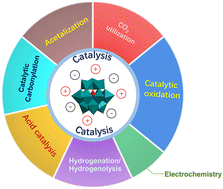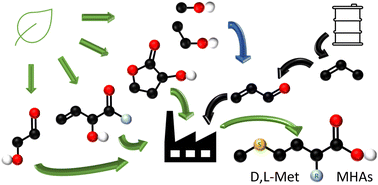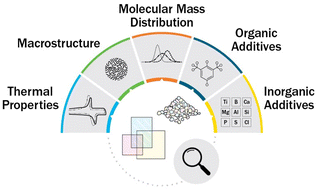Themed collection 2024 Green Chemistry Hot Articles

A promise to a sustainable future: 10 years of the Green Chemistry Commitment at Beyond Benign
The Green Chemistry Commitment (GCC) was founded in 2013 to host a community of practice around green chemistry in higher education. 10 years later, the GCC empowers a worldwide community to use chemistry tools to create a sustainable planet.

Green Chem., 2024,26, 6983-6993
https://doi.org/10.1039/D4GC00575A
Ionic liquid-stabilized metal oxoclusters: from design to catalytic application
This perspective provides the design, stability and unique properties regarding ionic liquid-stabilized metal oxoclusters and their application in catalysis, and also illustrates the future development of ionic liquid-stabilized metal oxoclusters.

Green Chem., 2024,26, 5127-5149
https://doi.org/10.1039/D4GC00515E
A perspective on renewable production of amino acids from biomass through the chemocatalytic method
This perspective showcases recent advances in amino acid synthesis from biomass through the chemocatalytic method.

Green Chem., 2024,26, 4468-4476
https://doi.org/10.1039/D4GC00846D
Covalent porous catalysts for electrochemical reduction of CO2
This article reviews different types of covalent porous catalysts for eCO2RR, including their design principles, the latest progress and their structure–activity relationships reported in recent literature.

Green Chem., 2024,26, 5744-5769
https://doi.org/10.1039/D4GC00717D
Electroreductive upgradation of biomass into high-value chemicals and energy-intensive biofuels
Recent advances in electroreductive upgradation of biomass to high-value chemicals and energy-intensive biofuels via various transformation routes are showcased.

Green Chem., 2024,26, 2454-2475
https://doi.org/10.1039/D3GC04543A
Tapping into the natural aromatic potential of microbial lignin valorization towards aromatic fine chemicals
Microbial lignin valorization unleashes the inherent aromatic potential of lignin to maximize the production of aromatic fine chemicals.

Green Chem., 2024,26, 11378-11405
https://doi.org/10.1039/D4GC03567D
Chemical recycling of polyester textile wastes: shifting towards sustainability
Amongst all synthetic polymers used in the clothing industry, polyethylene terephthalate (PET) is the most widely used polyester, its fibres representing half the total PET global market (in comparison bottle PET being less than a third).

Green Chem., 2024,26, 6857-6885
https://doi.org/10.1039/D4GC00911H
Electrocatalytic C–N coupling for urea synthesis: a critical review
Strategies for building efficient electrocatalytic urea synthesis systems.

Green Chem., 2024,26, 4908-4933
https://doi.org/10.1039/D3GC04920E
Methionine and its hydroxy analogues: the paths toward their sustainable chemical synthesis
We reviewed the current oil-based and novel renewables pathways for the chemical synthesis of methionine and its hydroxy analogues. Their sustainability advantages and disadvantages were critically assessed.

Green Chem., 2024,26, 4242-4269
https://doi.org/10.1039/D3GC03826B
Hypervalent iodine chemistry with a mechanochemical twist
An assessment of mechanochemistry's utility with hypervalent iodine reagents highlighted its effectiveness, which showed better selectivity, reaction times and differing reactivity.

Green Chem., 2024,26, 11518-11523
https://doi.org/10.1039/D4GC04903A
N–N atropisomer synthesis via electrolyte- and base-free electrochemical cobalt-catalysed C–H annulation
An exogenous electrolyte- and base-free electrochemical cobalt-catalysed atroposelective C–H annulation has been established to construct N–N axially chiral isoquinolinones in excellent enantioselectivities and good yields.

Green Chem., 2024,26, 11524-11530
https://doi.org/10.1039/D4GC04390A
Recycling organoiridium waste to [(1,5-cyclooctadiene)IrCl]2
Oxidative degradation of organoiridium waste by bleach enables quantitative iridium recovery without generating the highly inert metal. Based on that, we developed an ideal method for iridium recycling in academic-scale laboratories.
![Graphical abstract: Recycling organoiridium waste to [(1,5-cyclooctadiene)IrCl]2](/en/Image/Get?imageInfo.ImageType=GA&imageInfo.ImageIdentifier.ManuscriptID=D4GC00151F&imageInfo.ImageIdentifier.Year=2024)
Green Chem., 2024,26, 3146-3148
https://doi.org/10.1039/D4GC00151F
Beyond acceptable limits: intrinsic contamination in commercial 15N2 impedes reliable N2 reduction experiments
The validity of N2 reduction experiments relies on control experiments with isotopically labelled 15N2. Commercially obtained 15N2 contains high amounts of 15NH3 and other activated nitrogen species which are readily reduced to 15NH3.

Green Chem., 2024,26, 1302-1305
https://doi.org/10.1039/D3GC04272C
EtOH-mediated cascade C(sp3)–H alkylation via aromatization-driven [1,6]-hydride transfer: green and divergent synthesis of spirocyclic azepino[4,3,2-cd]indoles
Unprecedented EtOH-mediated cascade C(sp3)–H alkylation reactions of 4-dialkylamino-indole-3-carbaldehydes have been realized for the green and divergent synthesis of spirocyclic azepino[4,3,2-cd]indole derivatives.
![Graphical abstract: EtOH-mediated cascade C(sp3)–H alkylation via aromatization-driven [1,6]-hydride transfer: green and divergent synthesis of spirocyclic azepino[4,3,2-cd]indoles](/en/Image/Get?imageInfo.ImageType=GA&imageInfo.ImageIdentifier.ManuscriptID=D4GC04534C&imageInfo.ImageIdentifier.Year=2024)
Green Chem., 2024,26, 11899-11907
https://doi.org/10.1039/D4GC04534C
The effects of polyolefin structure and source on pyrolysis-derived plastic oil composition
Seven types of plastics, from varied structures and sources, were pyrolyzed in a fluidized bed reactor. The resulting oils were analyzed by GC×GC, NMR, and ICP, while theory and experiments were combined to explore the degradation mechanism.

Green Chem., 2024,26, 11908-11923
https://doi.org/10.1039/D4GC04029E
Upcycling atmospheric CO2 to polyhydroxyalkanoates via sequential chemo-biocatalytic processes
From atmospheric CO2 to green plastics, a sustainable journey.

Green Chem., 2024,26, 11885-11898
https://doi.org/10.1039/D4GC04228J
Solid–liquid separation of lignocellulosic sugars from biomass by rotating ceramic disc filtration
A simple, low energy, and productive filtration method to clarify biomass hydrolysate to enable biochemical and thermochemical pathways to biofuels and biochemicals.

Green Chem., 2024,26, 11587-11599
https://doi.org/10.1039/D4GC04533E
Augmentation of Pd-catalysed oxidative C–H/C–H carbonylation through alternating current electrosynthesis
Unsymmetrical-waveform AC electrolysis facilitates Pd-catalysed oxidative C–H/C–H carbonylation. This methodology highlights the substantial benefits conferred by Pd-catalysed conversions in comparison to traditional DC electrolysis.

Green Chem., 2024,26, 11177-11181
https://doi.org/10.1039/D4GC04569F
Chemodivergent alkylation of trifluoromethyl alkenes via photocatalytic coupling with alkanes
A photocatalytic methodology for the chemodivergent direct cross-coupling of simple alkanes with trifluoromethyl alkenes that enables the selective formation of gem-difluoroalkenes and trifluoromethyl alkanes is presented.

Green Chem., 2024,26, 11196-11205
https://doi.org/10.1039/D4GC04176C
Catalyst free PET and PEF polyesters using a new traceless oxalate chain extender
When producing PET the metal catalyst (typically Sb) remains in the polymer. This raises concerns as our food and the air we breathe is contaminated with PET microplastics. Here we report the production of metal-free PET using a small amount of DGO.

Green Chem., 2024,26, 11182-11195
https://doi.org/10.1039/D4GC02791D
Light-driven ultrafast dual C–C cleavage and coupling of dihydroxyacetone into high-purity carbon monoxide and ethylene glycol
Reforming of biomass-based dihydroxyacetone to produce high-purity CO and ethylene glycol is achieved via a distinctive photochemical process under ambient conditions.

Green Chem., 2024,26, 10859-10866
https://doi.org/10.1039/D4GC04180A
Environmentally friendly Miyaura Borylations allowing for green, 1-pot borylation/Suzuki–Miyaura couplings
A new method for installing the B(Epin) boronic ester leads to stable, functionalized borylated aromatic products under near-neat conditions, thereby allowing for sustainable Suzuki-Miyaura couplings.

Green Chem., 2024,26, 10115-10122
https://doi.org/10.1039/D4GC03115F
Can post-plasma CH4 injection improve plasma-based dry reforming of methane? A modeling study
Comparison of classical dry reforming of methane (DRM) with DRM based on CO2 plasma with post-plasma CH4 injection.

Green Chem., 2024,26, 9712-9728
https://doi.org/10.1039/D4GC02889A
Development of a solvent sustainability guide for the paints and coatings industry
A guide has been developed, highlighting various sustainability criteria of solvents used in the paints and coatings industry.

Green Chem., 2024,26, 9697-9711
https://doi.org/10.1039/D4GC01962H
Optimization of 5-hydroxymethylfurfural oxidation via photo-enzymatic cascade process
Trametes versicolor's laccase (LacTV) was efficient catalyst in HMF oxidation to FDCA. Its use in an enzymatic and photocatalytic cascade process permitted a 40-fold increase in FDCA productivity compared to traditional enzymatic batch systems.

Green Chem., 2024,26, 8211-8219
https://doi.org/10.1039/D4GC00673A
Wood-inspired dual-scale directional channel cellulose bioreactors with high mass transfer efficiency for continuous flow catalytic green conversion
A cellulose bioreactor with dual-scale directional channels and a porous inner wall is reported for the continuous catalytic conversion of polydatin into resveratrol, which can achieve a high conversion rate of 98.58% of resveratrol within 2 h.

Green Chem., 2024,26, 8256-8266
https://doi.org/10.1039/D3GC04421A
A waste-minimized approach for the synthesis of iodinated organic borazines
We herein report a waste-minimized process for the synthesis of iodinated hexa-aryl borazines in different iodination patterns and amounts.

Green Chem., 2024,26, 7752-7758
https://doi.org/10.1039/D4GC00699B
Molecular structure and composition elucidation of an industrial humin and its fractions
The structure of humins, a major side-product of carbohydrate biorefining, is complex and to a large extent unknown. A multitechnique characterization of an industrial humin provides new structural insights.

Green Chem., 2024,26, 7739-7751
https://doi.org/10.1039/D4GC00429A
Efficient access to hexaaryl-substituted borazines in batch and continuous-flow
Green inspired synthesis of hexaaryl-substituted borazines.

Green Chem., 2024,26, 7059-7066
https://doi.org/10.1039/D4GC00830H
Characterization of polymer properties and identification of additives in commercially available research plastics
This work reports the analysis of 59 commercially available polymers from 20 different polymer classes for thermal properties, macrostructure, molecular mass distribution, and inorganic and organic additives, highlighting the need to characterize research polymers prior to recycling studies.

Green Chem., 2024,26, 7067-7090
https://doi.org/10.1039/D4GC00659C
Integrating climate policies in the sustainability analysis of green chemicals
The grand transition towards green pathways for chemical production, alongside ambitious climate policies, could achieve 90% reduction in climate change impacts by 2050, while fossil routes offer a reduction of 10% in the best case.

Green Chem., 2024,26, 6461-6469
https://doi.org/10.1039/D4GC00392F
Mechanochemical aerobic oxidative Heck coupling by polymer-assisted grinding: cyclodextrin additive facilitating regioselectivity control
A novel approach utilizing the polymer-assisted grinding (POLAG) technique to facilitate the regioselective oxidative Heck coupling of aryl boronic acids with electronically unbiased olefins under solvent-free conditions was presented.

Green Chem., 2024,26, 5890-5899
https://doi.org/10.1039/D4GC01006J
A solvent-free mechanochemical electrophilic C–H thiocyanation of indoles and imidazo[1,2-a]pyridines using a cost-effective combination of N-chlorosuccinimide-NaSCN and tandem C–C and C–S bond formation
Herein, we demonstrate a solvent-free and cost-effective mechanochemical electrophilic thiocyanation of indoles and imidazo[1,2-a]pyridines and tandem double C–H activation leading to the formation of C-2 aryl and C-3 thiocyano indoles in a mixer-mill.
![Graphical abstract: A solvent-free mechanochemical electrophilic C–H thiocyanation of indoles and imidazo[1,2-a]pyridines using a cost-effective combination of N-chlorosuccinimide-NaSCN and tandem C–C and C–S bond formation](/en/Image/Get?imageInfo.ImageType=GA&imageInfo.ImageIdentifier.ManuscriptID=D4GC00486H&imageInfo.ImageIdentifier.Year=2024)
Green Chem., 2024,26, 5879-5889
https://doi.org/10.1039/D4GC00486H
Orthogonal assisted tandem reactions for the upgrading of bio-based aromatic alcohols using chitin derived mono and bimetallic catalysts
The upgrading of a benzyl-type alcohols was explored via an orthogonal tandem sequence comprised of a first oxidative step producing the corresponding aldehydes, and a subsequent reductive amination to achieve both secondary and tertiary amines.

Green Chem., 2024,26, 5221-5238
https://doi.org/10.1039/D3GC04848A
Interactions of multiple metrics and environmental indicators to assess processes, detect environmental hotspots, and guide future development
Sustainable development of pharmaceuticals relies on the selection and integration of unified metrics and indicators. Herein, we present a standardized method to assess, report, and communicate environmental sustainability of development processes.

Green Chem., 2024,26, 5239-5252
https://doi.org/10.1039/D4GC00302K
Synthesis of the dibenzo[b,d]azepine skeleton via a catalyst-free ring expansion domino reaction
A hitherto unreported catalyst-free ring expansion reaction of tetrahydroisoquinolines with o-alkynylarylaldehydes for the construction of the dibenzo[b,d]azepine skeleton is described.
![Graphical abstract: Synthesis of the dibenzo[b,d]azepine skeleton via a catalyst-free ring expansion domino reaction](/en/Image/Get?imageInfo.ImageType=GA&imageInfo.ImageIdentifier.ManuscriptID=D3GC04626E&imageInfo.ImageIdentifier.Year=2024)
Green Chem., 2024,26, 3786-3790
https://doi.org/10.1039/D3GC04626E
Development of a high-efficiency and environmentally friendly melamine–formaldehyde resin-based solid phase microextraction fiber for enhanced extraction of polycyclic aromatic hydrocarbons from environmental water
A new eco-friendly method was developed to synthesize rough surface, uniform particle size, and high heat-resistant fiber coating materials in water medium, achieving a remarkable enrichment capacity for trace pollutants in environmental water.

Green Chem., 2024,26, 3211-3220
https://doi.org/10.1039/D3GC04764D
The effect of lignin molecular weight on the formation and properties of carbon quantum dots
Five different Mw fractionated lignins were used to prepare five types of L-CQDs for general cell imaging and to clarify the effects of lignin Mw on the formation and properties of L-CQDs.

Green Chem., 2024,26, 3190-3201
https://doi.org/10.1039/D3GC04694J
Upgrading AquaSolv Omni (AqSO) biorefinery: access to highly ethoxylated lignins in high yields through reactive extraction (REx)
Ethanol-mediated reactive extraction is a green and simple process to simultaneously extract and functionalize lignin from wood. Ethoxy groups were incorporated in up to 40.8/100 Ar and the lignins were found suitable for adhesive formulations.

Green Chem., 2024,26, 2623-2637
https://doi.org/10.1039/D3GC03776B
Carbon footprint and mitigation strategies of three chemistry laboratories
Three chemistry laboratories assess their 2019 carbon footprint. Purchases and energy are key emissions. Mitigation aims for a 40–50% global reduction by 2030, addressing all categories.

Green Chem., 2024,26, 2613-2622
https://doi.org/10.1039/D3GC03668E
Stabilization of Cu+ sites by amorphous Al2O3 to enhance electrochemical CO2 reduction to C2+ products
The stabilized amorphous Al2O3 phase stabilizes the Cu+ site through oxidation state control, thereby improving the selectivity and activity for the production of the C2+ product.

Green Chem., 2024,26, 2599-2604
https://doi.org/10.1039/D3GC04492K
Preparation of reusable copper-based biomass-carbon aerogel catalysts and their application in highly selective reduction of maleimides to succinimides with hydrosilane as a hydrogen source
A novel copper-based biomass-carbon aerogel catalyst was prepared as a highly efficient and selective catalyst for maleimides reduction for the first time with excellent catalytic activity, chemo-selectivity, and recyclability.

Green Chem., 2024,26, 2592-2598
https://doi.org/10.1039/D3GC04697D
Mechanically accelerated catalytic hydrogenation: correlating physical state, reaction rate, and interface area
This study thoroughly examines the role of mechanochemistry in organic synthesis by analysing the factors affecting the mechanochemical reduction process of unsaturated and oxidized compounds.

Green Chem., 2024,26, 1927-1934
https://doi.org/10.1039/D3GC03783E
About this collection
Welcome to our online rolling collection of the hottest work published in Green Chemistry. Here we feature all of the 2024 articles highlighted as HOT by our Editors and Referees. Congratulations to all those featured!